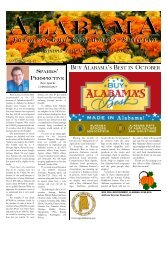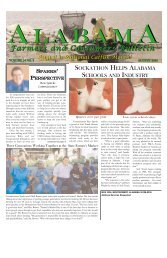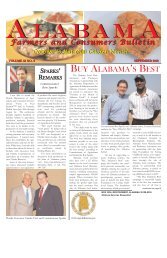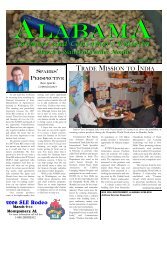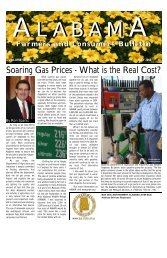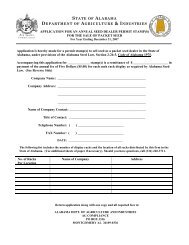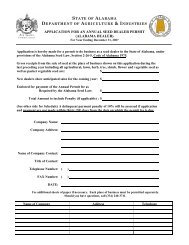Lessons Learned from Rural Schools - Alabama Department of ...
Lessons Learned from Rural Schools - Alabama Department of ...
Lessons Learned from Rural Schools - Alabama Department of ...
You also want an ePaper? Increase the reach of your titles
YUMPU automatically turns print PDFs into web optimized ePapers that Google loves.
LLS-0010 <strong>Lessons</strong> <strong>Learned</strong>_Pub.qrk: 4/25/09 3:02 PM Page 9<br />
The Reality <strong>of</strong> Being <strong>Rural</strong><br />
In 1986 the Commission on the Future <strong>of</strong> the South<br />
published a much-acclaimed report, Halfway Home & a<br />
Long Way to Go which stated: “The sunshine on the<br />
Sunbelt has proved to be a narrow beam <strong>of</strong> light, brightening<br />
futures along the Atlantic Seaboard, and in large<br />
cities, but skipping over many small towns and rural<br />
areas.”<br />
This statement rings as true for rural <strong>Alabama</strong> in 2009<br />
as it did for the South 23 years ago because the majority<br />
<strong>of</strong> economic progress <strong>Alabama</strong> experienced the past two<br />
decades was largely “skipping over many small towns and<br />
rural areas.”<br />
The facts are undeniable.<br />
• In February 2009 there were 37 counties in <strong>Alabama</strong><br />
with double-digit unemployment, 34 <strong>of</strong> them rural.<br />
• Figures <strong>from</strong> the <strong>Alabama</strong> <strong>Department</strong> <strong>of</strong> Industrial Relations<br />
show that <strong>from</strong> 1998 to 2008, 31 rural counties lost<br />
employment.<br />
• The last census showed that fewer than 10 percent <strong>of</strong> all<br />
people over 25 years <strong>of</strong> age in 26 <strong>Alabama</strong> counties had<br />
finished college. (The state average is 19 percent.) Of<br />
these, 23 were rural counties.<br />
• The most productive and active adults are between the<br />
ages <strong>of</strong> 25 and 44, yet when you look at this segment <strong>of</strong><br />
the population, 29 rural counties rank in the bottom onehalf<br />
<strong>of</strong> the state in percent <strong>of</strong> adults in this age range.<br />
Against this backdrop, it’s not hard to understand why<br />
enrollment in public schools declined in 37 rural counties<br />
<strong>from</strong> 1997-98 to 2007-08. Or why <strong>of</strong> the 494 schools in<br />
rural <strong>Alabama</strong>, none <strong>of</strong> them have less than 10 percent<br />
free-reduced lunch students while 78 have 90 percent or<br />
more.<br />
Information such as this provides the context that must<br />
be understood in looking at rural education and the circumstances<br />
facing education pr<strong>of</strong>essionals in such areas.<br />
This is especially true as you look at community impact on<br />
rural education.<br />
Lewis Terman joined the faculty at Stanford University<br />
in 1910 and later chaired the psychology department for<br />
20 years. Terman was fascinated by the concept <strong>of</strong> measuring<br />
human intelligence. In fact, he coined the term “intelligence<br />
quotient” and some <strong>of</strong> his work lives on today<br />
<strong>Lessons</strong> <strong>Learned</strong> <strong>from</strong> <strong>Rural</strong> <strong>Schools</strong> – May 2009<br />
embodied in the Stanford Aptitude Test which every high<br />
school student knows as the SAT.<br />
In the 1920s Terman and his assistants identified 643 elementary<br />
students in California with IQs <strong>of</strong> 135 or higher.<br />
The pr<strong>of</strong>essor then set about collecting mountains <strong>of</strong> data<br />
on each child, looking at such things as physical health, interests,<br />
ancestry, reading habits, home life, household income<br />
and parental occupations. But his initial work was<br />
just the beginning as Terman followed these subjects until<br />
his death in 1956.<br />
As Malcolm Gladwell points out in his book, Outliers,<br />
when the subjects were into their adulthood, Terman reviewed<br />
their accomplishments and divided them into three<br />
groups.<br />
The “A” group was the cream <strong>of</strong> the crop, the lawyers,<br />
physicians, engineers and academics. Ninety percent <strong>of</strong><br />
them graduated <strong>from</strong> college. The “B” group was those<br />
Terman deemed as doing “satisfactorily.” And the “C”<br />
group was made up <strong>of</strong> those the pr<strong>of</strong>essor felt had done<br />
the least with their superior mental ability. One-third <strong>of</strong><br />
them dropped out <strong>of</strong> college and 25 percent only had a<br />
high school education.<br />
After exhaustive research Terman concluded that the<br />
only meaningful difference in all three groups was their<br />
family background.<br />
“The As overwhelmingly came <strong>from</strong> the middle and<br />
upper class,” Gladwell says. “Their homes were filled with<br />
books. Half the fathers had a college degree or beyond.”<br />
By comparison, almost one-third <strong>of</strong> the Cs had a parent<br />
who had dropped out <strong>of</strong> school before the eighth grade.<br />
“What did the Cs lack?” asks Gladwell. “They lacked<br />
something that could have been given to them if we’d only<br />
known they needed it: a community around them that<br />
prepared them properly for the world.”<br />
Within the last decade sociologist Annette Lareau conducted<br />
a study <strong>of</strong> third-graders that dovetails with the<br />
findings <strong>of</strong> Terman. She studied 88 families that included<br />
black and white, middle-class, working class and poor.<br />
After countless hours observing each family, Lareau concluded<br />
that middle-class families use a parenting strategy<br />
she calls “concerted cultivation,” while working-class and<br />
poor families use a very different strategy she calls “the accomplishment<br />
<strong>of</strong> natural growth.”<br />
The former involves intensive verbal interactions, lots <strong>of</strong><br />
scheduled activities such as sports and music lessons, as<br />
well as parental intervention with schools to get them to<br />
accommodate children’s individual needs and preferences.<br />
9




